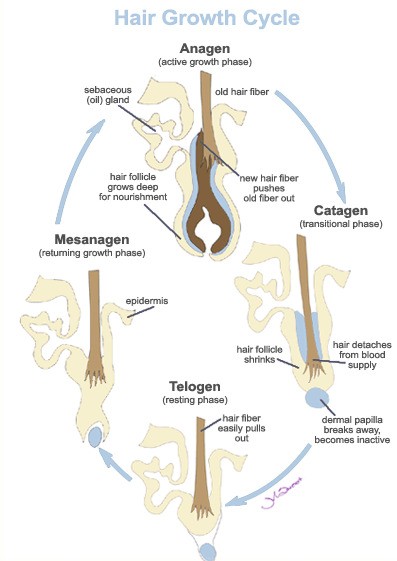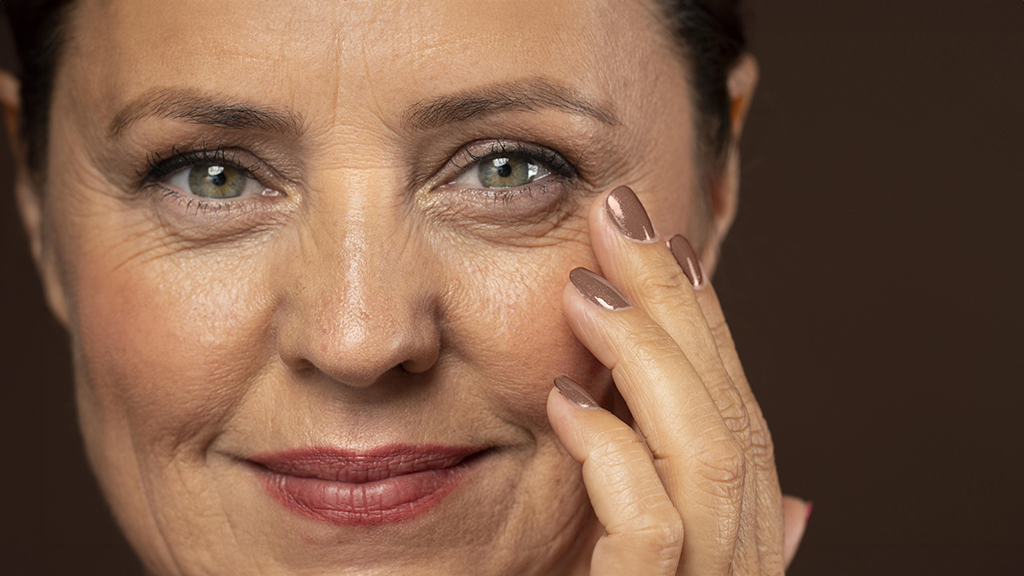Laser Treatment

To understand how the laser hair removal procedure works, it is first necessary to understand a little about how your hair actually grows.
Hair follicles themselves develop through a series of interactions between various elements within the skin, with the result that not all hairs will be growing at the same time. Hair grows in repeated cycles, and within each cycle there are 3 phases involved:
- Anagen – the active growth phase during which the hair is visible above the skin.
- Catagen – the transitional phase during which the hair follicle shrinks, the growth process reverses and the hair is preparing to shed.
- Telogen – the resting phase during which the hair is neither developing nor growing, and is not usually visible above the skin. This phase can be as short as a few days or as long as a few years.
During the Telogen phase of the growth cycle, laser treatment is ineffective in arresting hair growth.
Following the Telogen phase, the Anagen phase recommences with the formation of a new hair. If at this point the old hair has not already shed, then the new hair pushes out the old one and the growth cycle recommences.

It is important to understand that each hair passes through its growth cycle independently from the other hairs nearby, and that the ideal time for laser treatment of a hair is during the Anagen phase, which can be as long as two or three weeks in duration. During this time it is exposed above the skin. It is now that the laser light can attack the melanin in the hair shaft and disable the dermal papilla at the base of the follicle which is fed by the blood stream carrying nutrients to produce new hair.
Since the growth cycles of the individual hairs are not synchronized, the Laser Hair Removal treatment must be carried out in several sessions over an extended period of time, so as to ensure that all hairs within the treatment zone will be subjected to the laser at the appropriate time.
You must also understand that, regardless of what you might have heard or read elsewhere, laser treatment will NOT permanently remove all hair. It can nevertheless significantly reduce hair growth to what often seems to be a permanent state, with any re-growth likely to be paler and weaker.
How the Laser Treatment is Performed
At Elite Plastic & Cosmetic Surgery Group we use a system that employs both the Alexandrite and Nd:Yag lasers, both separately and in combination. The Alexandrite laser is the fastest for hair removal, and is most effective on patients with lighter to olive-coloured skin. The Nd:Yag laser is a little slower but can be used effectively for all patients, including those with very tanned or dark skin.
Immediately before the treatment, the hair to be treated will be shaved. The laser itself will be adjusted according to your hair colour and thickness, your skin tone and also the region on the body where the hair is situated.
You will wear protective eyeware to shield your eyes from the laser light.
To commence the procedure, the laser applicator is placed on the skin surface and a short pulse of light will be released. This light pulse is able to target many hair follicles simultaneously. The applicator is then moved to a neighbouring region of skin and the process is repeated until the entire region has been treated.
The treatment can last from as little as 10 minutes to as long as an hour, depending upon the size of the region treated. Throughout the duration of the treatment, cold air will be applied to the skin to reduce any discomfort.
How the Laser Treatment Feels
The sensation of laser treatment can vary but it has frequently been described as “tingling” or “warm and prickly”, with any discomfort being mild and tolerable. Generally no local anaesthetic will be required. However, to provide patients with increased comfort, cool air will be applied to the area before and during treatment.
Following the Treatment
Immediately following the treatment, the skin might appear red and hair follicles perhaps swollen and bumpy. However this will usually disappear after a few hours.
You can return to your daily routine straight away. However it is recommended that sunscreen be applied to any treated areas that will be exposed to the sun.
Subsequent Treatment Sessions
Since only hair that is actively growing can be treated by the laser (see above for a description of the hair growth cycle), and different hairs will be at different points within their growth cycles, several laser treatment sessions will be required. The precise number of treatments varies, but it is entirely possible that 6 or more treatment sessions will be needed in order to obtain the best possible results.
Most patients will benefit from a 80%-90% reduction in hair growth, and although the results of laser treatment are permanent, some patients may require occasional touch-up sessions to treat individual hairs.
Side-Effects and Risks of Laser Hair Removal
Although Laser Hair Removal is very safe, there are nevertheless some potential side-effects and risks. Understanding these possible side-effects and risks will enable you to make an informed decision. At your consultation our laser specialist will explain to you all aspects of the procedure.
Short-term side effects of Laser Hair Removal may include redness and swelling. This will typically subside after a few hours. In rare circumstances, adverse reactions might occur which could include a small blister or temporary skin lightening or darkening.
Laser Hair Removal works best and has the fewest risks with pale skin. It does not always work well on red hair or grey hair.
For those with darker complexions, there is the risk of too much laser energy being absorbed, resulting in skin damage. However the technology within our Nd:Yag laser enables us to control the level of energy absorption, thus making it also suitable for treating darker skin types with reduced likelihood of adverse side-effects.
Laser Hair Removal treatment should be avoided if you are particularly sensitive to light or have any infection in the region of the treatment area.
You should avoid Laser Hair Removal treatment if you have been treated for acne using Isotretinoin during the foregoing 12 month period.
The Consultation Procedure
Prior to Laser Treatment, you will be offered a free consultation, during which a medical history will be taken to confirm you as a suitable candidate for Laser Hair Removal treatment. Our laser specialist will also advise you on all key aspects of the procedure. This is also an ideal opportunity for you to pose any questions that you might have.
Before the treatment commences you will be asked to give your informed consent to the procedure by signing a consent form, and a small patch test will be carried out at least 24 hours prior to your first treatment session.
For details about procedures and treatments or for a consultation, advice and prices from our Dubai clinic please call +971 4 431 2396 or use our online form.



